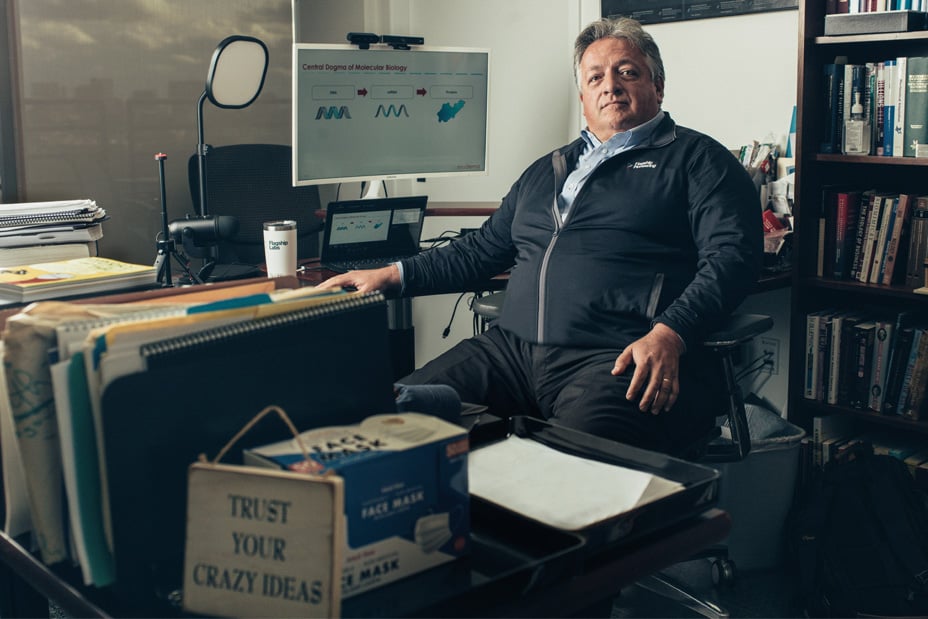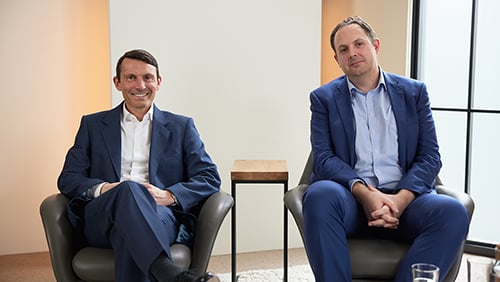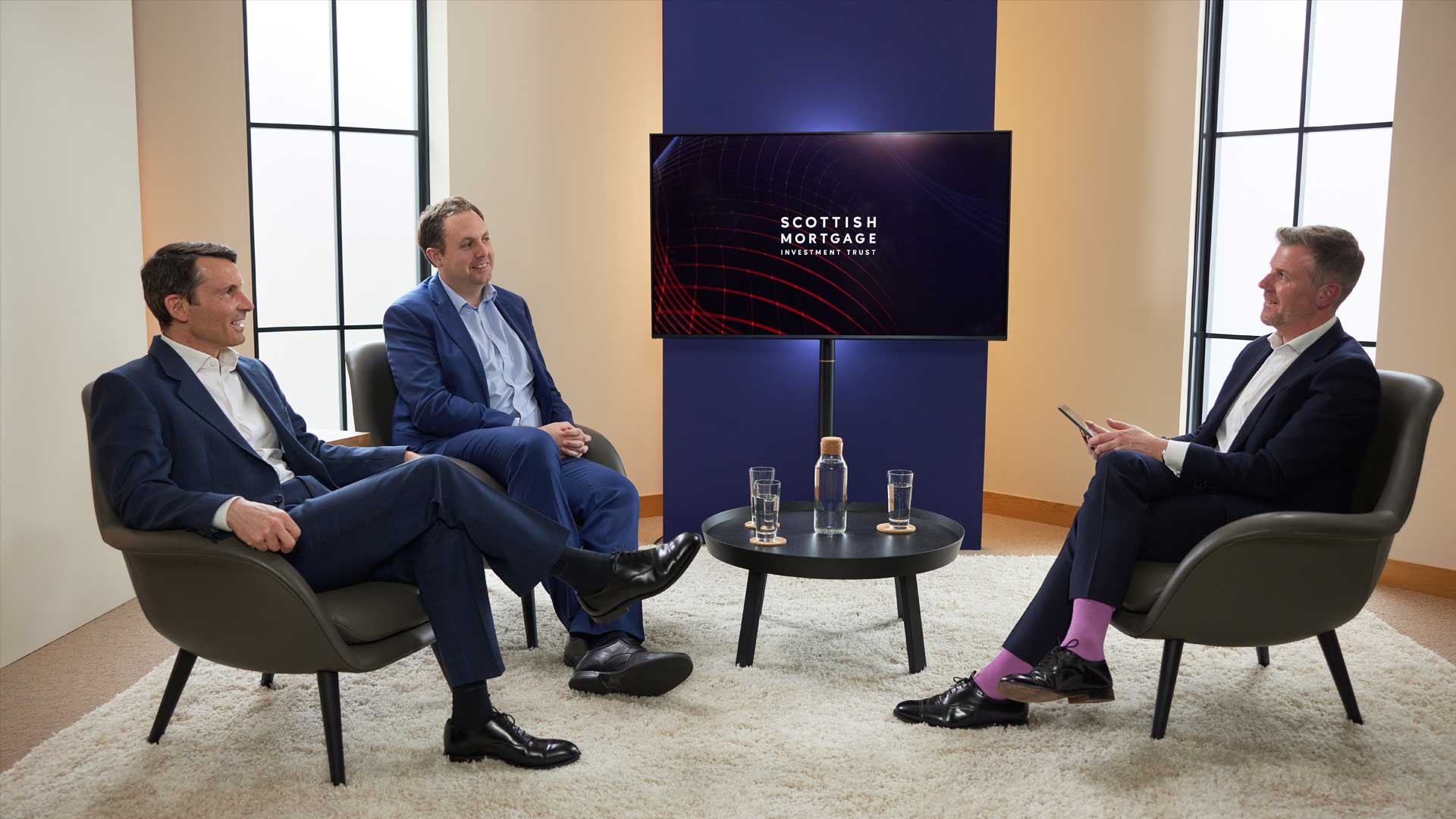Stay on the road less travelled
James Anderson – Investment manager
In his final review as joint manager of Scottish Mortgage Investment Trust, James Anderson reflects on the challenge and excitement of the search for extreme returns. Anticipating greater change to come, he urges investors to keep thinking distinctively.

The value of shares in Scottish Mortgage, and any income from them, can fall as well as rise and investors may not get back the amount invested.
After many years of anodyne reviews perhaps some bluntness is permissible in this final and twenty second version. There’s much that I have misunderstood and misjudged over the two decades but my ever-growing conviction is that my greatest failing has been to be insufficiently radical. To be blunt: the world of conventional investment management is irretrievably broken. It demands far in excess of the canonical ‘six impossible things before breakfast’ that Alice in Wonderland propounds.
Some contentions
But let me start by trying to set out what I do believe. Hopefully it doesn’t need saying that my successors should be suspicious of continuing to believe in these contentions for the next decades. As the world changes so should we. Indeed this is an appropriate point of departure. The investment world changed profoundly in the mid 1980’s. It resembles that most famously described by Ben Graham, the apostle of value investing, paid homage to by Warren Buffett and perpetually embraced by the media, as little as Alice’s rabbit hole described the reality of the late 19th century. To illustrate the change from the world in which a growth stock was defined by Graham as one able to double earnings in a single decade let’s look at some more recent figures:

I’m sure that many of you will recognise these numbers as the annual revenues of Amazon. They rather understate progress as the accounting for third party fulfilment is conservative. But we still have a compound growth rate of 41% per annum for over two decades. For those, like Graham, who prefer the bottom line then 2020 produced $31bn in free cash flow. This pattern of sustained growth at extreme pace and with increasing returns to scale has become more and more evident since the emergence of digital technologies as first exemplified by Microsoft (still growing after 35 years as a public company).
It is in these extremes that investing resides. Despite what the CFA foists on the young and innocent you cannot choose a level of risk and return along a classic bell-curve to suit your portfolio because that is neither accepting the deep uncertainty of the world nor acknowledging that the skew of returns is so extreme that it is the search for companies with the characteristics that might enable extreme and compounding success that is central to investing. But distraction through seeking minor opportunities in banal companies over short periods is the perennial temptation. It must be resisted. This requires conviction. The share price drawdowns will be regular and severe. 40% is common. The stock charts that look like remorseless bottom left to top right graphs are never as smooth and easy as they subsequently appear.1
So how do we identify these stocks with extraordinary potential? How do we acquire the conviction to allow the compounding to work its magic? As Jeff Bezos steps down as CEO let’s look back at what we spotted, how we endured and what we failed to do for shareholders. The common factors that are most likely to recur in the narratives of great investments are that the company should have open-ended growth opportunities that they should work hard never to define or time, that it has initial leadership that thinks like a founder (and almost always is one) and that has a distinctive philosophy of business - almost always from independently thought through first principles. Now, I think that all these traits were identifiable in Amazon from the start. To read the initial shareholder letter of 1997 was to know that this was the ambitious, patient creation of a very special mind. To be frank our failure to recognise this was because of our own limitations not an absence of clues. We were simply too aware of market movements and too preoccupied with the terrible combination of short-term performance and fear of downside to be able to be committed owners. By 2005-6 we were less bad investors and could recognise some of the potential and endure more of the slings and arrows. Of those there were plenty: the share price fell 46% from peak to trough in 2006. I became used to peers at client conferences declaring Amazon their favourite short. They particularly disliked the costs of two projects - Prime and Amazon Elastic Compute. The latter became AWS. Gradually we learnt and understood. But we should apologise for our willingness to trim Amazon back repeatedly when our holding size approached 10% of assets. That was misguided. Only in recent months has our enthusiasm waned. Amazon is now seen as good value, safe and acceptable. It no longer has a founder CEO. We fear that in his inimitable terms it is no longer Day 1 in Seattle though the road ahead is still long and profitable.
1. Extreme Stock Market Performers, Part I: Expect Some Drawdowns; 21 July 2020; Professor Hendrik Bessembinder of Arizona State University
This paper studies the most successful decade-length returns for publicly-listed U.S. common stocks during each of the seven decades since 1950. It shows that even for the most highly-returning companies, share prices experienced significant draw-downs on their path to the top decade returns. For the top 100 companies by their decade returns, the draw-downs lasted an average of 10 months during that decade, with an average loss of 32.5%. For the top 200 companies, the average loss increased to 50%.
Time frames, likelihoods and radical uncertainty
The litany of reasons to be obsessed with long-term decision making is too long to describe here. But there’s an offshoot of it that seems unusually important yet neglected. It is inherent to the notion of efficient markets that all available information is incorporated in share prices. Only new information matters. This is used to justify the near pornographic allure of news such as earnings announcements and macroeconomic headlines. In turn this is reinforced by the power of near-term financial incentives.
So far this is a standard critique. We share it but there is a twist to come. If you believe that all information is built into the share price and simultaneously that it is near term investment outcomes that matter this leaves a vacuum of thought. There is no apparent rationale for deciphering the future. If this sounds abstract it’s not so. Let’s take a look at Tesla to illustrate the puzzle. When we first invested in the company seven years ago we thought, or rather observed, that the regularity and pace of improvement in battery performance and of learning in building electric vehicles was already clear in practice and well-elucidated in academic study. Since then both the pace of improvement and the level of confidence surrounding the data has risen consistently. This made it as close to inevitable as investing allows that at some point electric vehicles were going to be better and cheaper than the internal combustion engine - quite aside from environmental issues. That’s simply what happens when a 15% plus improvement rate meets a 2-3% snail.

Since Tesla was the only substantial Western player our investment decision was hardly demanding. We just had to listen to experts and wait. But most investors do not listen to experts. Instead they listen to brokers and the media, besotted as it is by fear mongering and the many short sellers. The headlines tell them that next quarter will be hard for Tesla and that Elon Musk is outspoken. To us this was a blatant market inefficiency offering an extraordinarily high likelihood of high returns to the patient. All too many investment decisions are marginal judgments. That electric vehicles would win had become intensely likely. We needed no insight, no clever model to spot it - only patience and trust in experts and the company. The uncertainty was elsewhere. It was elsewhere geographically - given the levels of competition in China it was profoundly uncertain that our investment in NIO would flourish or even survive. It was elsewhere in return calculations for Tesla itself. This particularly applies now and to Tesla’s autonomous driving ambitions. This could transform the economics of the company. But try though we do it seems implausible that we can estimate either the likelihood of success in a radically new endeavour nor the precise outcomes in cash-flows should success emerge. To us it is bizarre that brokers, hedge fund mavens and commentators can claim to be able to decipher the future and assign a precise numerical target to the value of Tesla. Perhaps they are all geniuses. We are not. We should respect and endure uncertainty, try to identify where extreme upside might occur and observe patiently.
It's not growth versus value
Tesla is but an example, if a crucial one, of the central issue for investing in our times. It isn’t growth versus value, it isn’t the level of markets, it isn’t the economic growth rate in 2021 or the progress of the pandemic but it is understanding change, how it happens, how much happens and its implications. The refusal to embrace this is probably a reflection of the doomed desire for security but it is also emblematic of a broader crisis in economic thought that is preoccupied with the mathematics of equilibrium. But if we switch our attention to studying deep change then there is less temptation to believe that investing has eternal verities that we can default to as a rule book. It’s not ‘this time it’s different’ that is the cry of danger but the refusal to admit that the world, and its reflection that is investing, is ever the same. The only rhyme is that in the long run the value of stocks is the long-run free cash flows they generate but we have but the barest and most nebulous clues as to what these cash flows will turn out to be. But woe betide those who think that a near term price to earnings ratio defines value in an era of deep change.

The future
There will almost certainly be more wrenching, inspiring and dramatic change in the next decade than we have ever seen. I’m very envious of the opportunities and experiences that my successors will enjoy. Even in the last year, amidst the tragedies of the pandemic, there have been hints of what is to come. I don’t mean the surge in digital platforms that helped to navigate the constraints of the pandemic but still more dramatic and important rising forces. From the extraordinary revolution that will transform our societies for the better in renewable energy becoming mainstream to the emerging wonders of synthetic biology to the possibility that healthcare innovation becomes a regular series of beneficial revolutions rather than a complex and frustrating drain of resources the potential is wonderful and the threat to old empires looms. It would have been hard for us to have educated ourselves in these areas of unashamed excitement without our involvement in venture capital. We are forever grateful that we have found our way to interact with the extraordinary minds and energies in the unquoted world. Frankly, five years ago I would have been amazed at the access and opportunities that we have come to take as normal. We are very fortunate. It’s a privilege. Our former Board member, John Kay, taught us many things but one of the most valuable was the role of obliquity. By engaging with visionary minds and their companies we are simply seeking insight into the world of tomorrow. Often we are overwhelmed and puzzled more than comprehending. That’s the plan. The investment outcomes are but the eventual outcomes of the mentality and process.
We need to remain eccentric. In fact we need to become more so and more prepared to be radical. We’ve always claimed to learn from the remarkable leaders we are lucky enough to meet in managing Scottish Mortgage. If I may I’d like to end by quoting two of them. The first is Noubar Afeyan, founder of Flagship health investors but also Chair of Moderna. A year ago I would at this point have needed to detail the purpose of Moderna but that is now delightfully redundant. But the comment I want to quote applies far beyond Moderna and vaccines:
“Let me say maybe something stark...which is that we have to be willing to embrace unreasonable propositions and unreasonable people in order to make extraordinary findings because the notion that utterly reasonable people doing utterly reasonable things will produce massive breakthroughs doesn’t compute to me”.
There is no industry more suspicious of the unconventional than fund management. We need to reinvent from first principles. We need to help create great companies that embrace the extraordinary. Plainly no one has been better at demonstrating and articulating this than Jeff Bezos. His recent, and sadly last, CEO letter concluded with a plea:
“We all know that distinctiveness - originality - is valuable...What I’m really asking you to do is to embrace and be realistic about how much energy it takes to maintain that distinctiveness. The world wants you to be typical - in a thousand ways, it pulls at you. Don’t let it happen”.
I don’t think Tom and Lawrence need this advice, or would neglect the views of Mr Bezos. But please help Scottish Mortgage become more unreasonable and more distinctive as the pressures of the investment world continue to pull at us.
Scottish Mortgage Annual Past Performance (%) To 31 March each year
| 2018 | 2019 | 2020 | 2021 | |
| Scottish Mortgage Investment Trust | 21.6 | 16.5 | 12.7 | 99.0 |
Past performance is not a guide to future returns.
About the author - James Anderson
Investment manager
James was the manager and then joint manager of Scottish Mortgage Investment Trust between 2000 and 2022. He was also a co-manager of the International Concentrated Growth and Global Outliers Strategies. James chaired the International Growth Portfolio Group from its inception in 2003 until July 2019 and was also Co-Manager of Vanguard International Growth. In 2003, James co-founded our Long Term Global Growth Strategy. Before that, he headed our European Equity team. James served as a member of the Advisory Board of the government-sponsored Kay Review and as Chair of the subsequent industry working group that set up the UK Investor Forum. He joined Baillie Gifford in 1983 and became a partner in 1987. James graduated BA in History from the University of Oxford, and after postgraduate study in Italy and Canada, he gained an MA in International Affairs in 1982. James is currently a Trustee of the Johns Hopkins University and Chairman of the Swedish investment company Kinnevik.
Important information
This communication was produced and approved at the time stated and may not have been updated subsequently. It represents views held at the time of production and may not reflect current thinking.
This content does not constitute, and is not subject to the protections afforded to, independent research. Baillie Gifford and its staff may have dealt in the investments concerned. The views expressed are not statements of fact and should not be considered as advice or a recommendation to buy, sell or hold a particular investment.
Baillie Gifford & Co and Baillie Gifford & Co Limited are authorised and regulated by the Financial Conduct Authority (FCA). The investment trusts managed by Baillie Gifford & Co Limited are listed on the London Stock Exchange and are not authorised or regulated by the FCA.
A Key Information Document is available by visiting our Documents page.
Any images used in this content are for illustrative purposes only.







